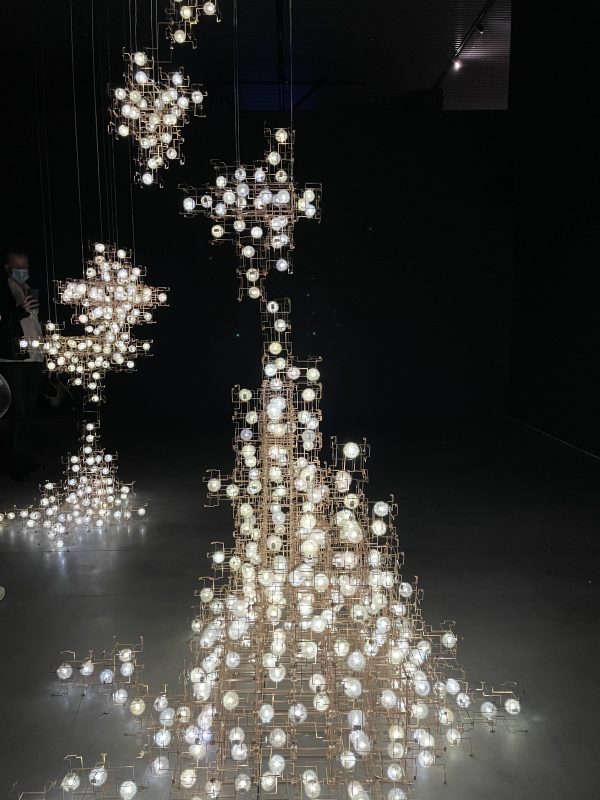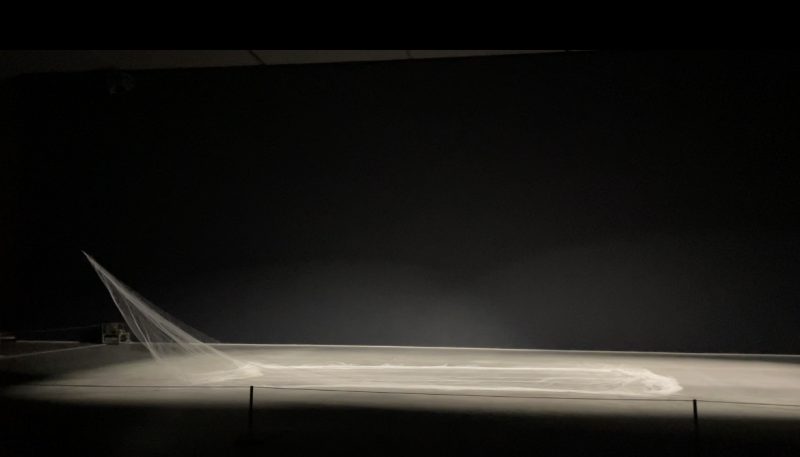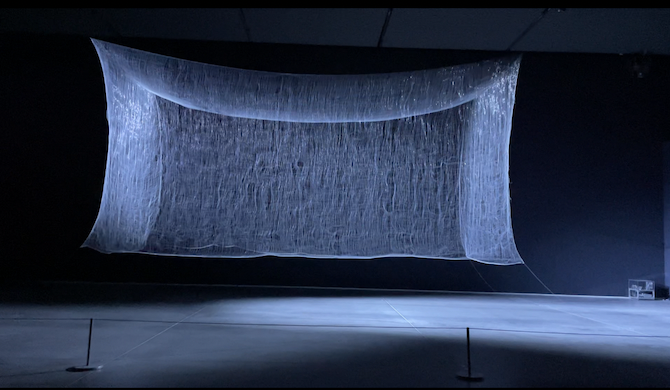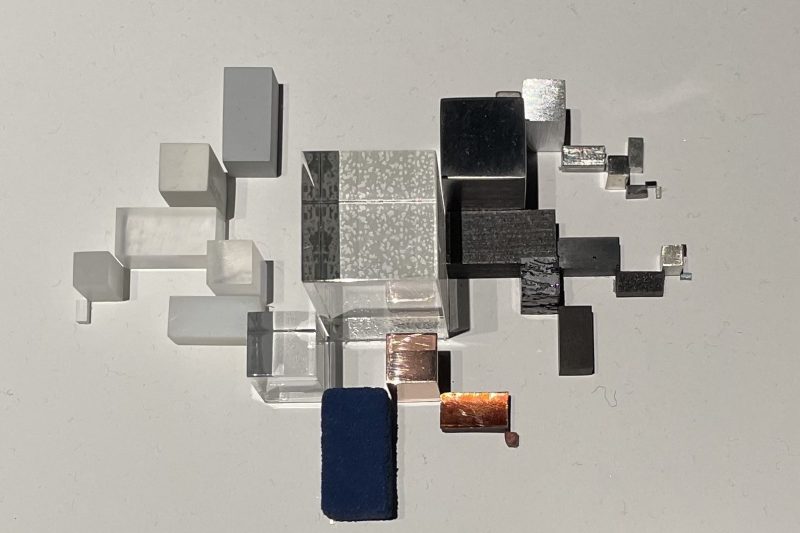Fragile Futures
Posted on October 25, 2021Studio DRIFT’s exhibition Fragile Futures is one of the reasons I believe art installations can be life-changing. As one enters the room, you dive into an immersive experience leaving the noise, daylight, and sense of being outside. I arrived at The Shed with no expectations and left the building with a feeling of fulfillment and awareness. The exhibition gave me a better sense of the interconnectedness of nature’s evolution and technological development, how our ego works as a system, and the positionality of designers to find usefulness in earth’s raw materials.
As you walk into the dark space, you are encountered by a sculpture of an electrical circuit connected to light-emitting dandelions. Studio DRIFT artists are from the Netherlands, the country best known for its flowers, allowing the artists to go to the fields looking for the biggest dandelions with the perfect shape. Once the flowers arrive at the studio, they need to become dry in order to pluck out the hairs and connect them to a small light – the dandelions return to their same appearance but have a technological body instead. It becomes an electrical dandelion. If you observe the things that surround us and how things in nature are constructed, it’s so complicated, so well done and so logical that makes you wonder if nature is not the high-tech part of this world. Scientists are inspired by nature and most of them try to mimic it to create new technology, but it can be said that in a way technology is an evolution from nature. This is a utopian vision of our future where nature and technology come together, but it is also questioned if the technological developments of this era are more important than nature’s evolution.


As I moved to the next room, I entered a space where I spent approximately 45 minutes sitting on a bench staring at this amazing masterpiece that moved in front of me. A massive woven block made of 9.5 miles of hair-thin Japanese fluorocarbon controlled by motors with algorithms allowing the shape to follow choreography. The block starts on the floor and begins to rise for a few seconds, then falls back again. It rises, gets distorted, moves through space, and falls again. After some minutes of rising and falling the block keeps its rigid shape at a very high height and it morphs its corners, stretches, shrinks, and when you think the rest of the choreography will be at that level suddenly it rapidly falls back to the floor and disappears. The intent of this art piece is to reflect on our ego. I connected this to what Donella Meadows explains in her book Thinking in Systems, one of the reasons systems work so well is due to its resilience: “the ability to bounce or spring back into shape, position, etc. after being pressed or stretched. The ability to recover strength, spirits, good humor, or any other aspect quickly.” And there is when I understood, the ego is a system that is nourished by feedback loops and can be restored and rebuilt. As the artists suggest “it displays the rigidness of our man-made systems and how they can become fluid or even collapse.” It gives the viewer a perspective on the world that we live in and how we relate to it. As I sat there, I experienced how our ego is this unconscious feeling and thought that sometimes it is stronger than our consciousness and it decides how we should behave in the world. I thought about how we live in a society ruled by millions of individual egos, who act on their personal benefit driving us to become egocentric and selfish beings instinctively.
Steven Johnson delivers an important reflection in Emergence: The Connected lives of Ants, Brains, Cities, and SoftwareEvery person thinks they know what they are doing,” and he gives reference to the decision making of ants existing on a minute–by–minute scale. On the other hand, human behavior works on a scale of survival in the future. We create and live with ego as we believe it is a fuel that will lead us to move forward and be on top of the pyramid. It was very interesting to see how this installation gives the viewer a better sense of how sometimes there are actions, words, people who can make our ego inflate and get bigger making the individual feel superior and worthy. But we are so vulnerable to the exterior world, that those same factors can as easily collapse the ego and pull us back to the ground. When Johnson talks about five fundamental principles to follow if one wants to create a system where macro-intelligence and adaptability derive from local knowledge, one of the most important rules (if not the most important) is to pay attention to your neighbors. He mentions how ants interact with neighbors in the field and allows the colony to regulate itself and become more effective. Without these interactions, the colony will be senseless and illogical. I think this is exactly what human beings need to learn to control their ego, think about others rather than yourself. Sometimes we are so focused on our own success that we decide to live inside of a rigid block with no windows to see what is going on around us that might need our attention. It is valid to have one’s sense of self-worth but not to the extreme where you become unaware of others. Just as the 9.5miles of hair-thin Japanese fluorocarbon communicated to us, you can be on the top for some minutes or hours, which can become years, but something can unexpectedly emerge and, in a millisecond, you will be at the bottom again.



As I kept walking away from this emotive experience, I was about to encounter another room full of realization. Materialism was the next installation Studio DRIFT produced. The artists selected mundane objects and reduced them to the exact quantity of the specific raw material from which they are made of. These sculptures reveal the unseen elements of our everyday life that are only considered and valued by their function and not by their essence. Looking at these products in such a simple and deconstructive way made me think how with industrialization, people’s objective has been to bring materials together mold by design to support our pleasant existence. We have created a system where we do more and more, filling our lives with these artificial and materialistic things. Seeing a bicycle, an iPhone, a pencil, and a hamburger among others, de-constructed helped me remember what many of our professors in Transdisciplinary Design had said at least once: as designers, it is easy for us to create things, come up with ideas and develop them, but we are challenged when we must unravel them, step back and de-produce things that are already produced. A discussion in one of our classes went into how doing and creating more things in the world might be harmful. When we think we are finding solutions to problems, we might be creating more. As Donna Haraway says “stay within the trouble,” meaning to stop trying to find a solution and be in the present with response-ability. DRIFT shows how much matter from the earth needs to be extracted for basic products to be made and tries to make the viewer understand the essential nature of our visible world. Everything that is built, we believe is for our own good for the use it can have in our lives but in reality, it has an impact upon complex systems of resource extraction, labor, and manufacturing that we are not aware of. As cognizant beings, we should be able to develop emergent behavior as “a quality of growing smarter over time and responding to the specific and changing needs of our environment,” learning when to stop the mass production that is a reinforcing loop in this consumerist society.

Studio DRIFT’s exhibition Fragile Futures has been for sure the best one I have seen in a while. It made me reflect on how us as human beings should go deeper in our consciousness to understand that technology should not take over nature, that we must live in a healthy relationship within ourselves and others leaving room for emergence to occur – and we should recognize some things don’t need human intervention to be valuable. There are many takeaways from this experience, and I would recommend everyone to go and allow themselves to be curious, not judgmental.”
MO
References:
Johnson, Steven. Emergence: The Connected Lives of Ants, Brains, Cities, and Software, Scribner, 2002. ProQuest Ebook Central, https://ebookcentral-proquest.com.libproxy.newschool.edu/lib/newschool/detail.action?docID=5653897.
Haraway, Donna J. Staying with the Trouble: Making Kin in the Chthulucene, Duke University Press, 2016. ProQuest Ebook Central, https://ebookcentral-proquest-com.libproxy.newschool.edu/lib/newschool/detail.action?docID=4649739.
DRIFT Fragile Futures. The Shed. (n.d.). Retrieved October 18, 2021, from https://theshed.org/program/217-drift-fragile-future.
“The Diamond Dogs.” Ted Lasso, created by Bill Lawrence, season 1, episode 8, Apple TV, 2020.